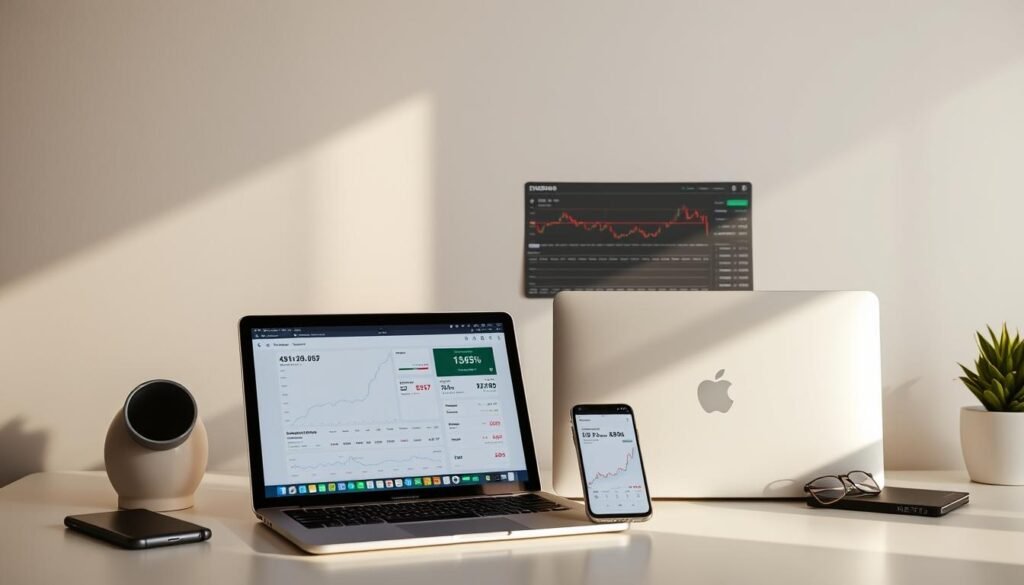
Find the Best Robo Advisor Apps USA for Beginners

You might remember the first time you wondered how to put spare cash to work. Maybe it was a $20 coffee that sparked a question: could that small amount grow into something bigger? This intro walks you through the simple start.
Automated investing uses algorithms to build and manage a portfolio that matches your goals, time horizon, and risk tolerance. Platforms like Betterment, Fidelity Go, Wealthfront, Schwab Intelligent Portfolios, Vanguard Digital Advisor, and Acorns make investments easier with low minimums, clear fee structures, and features like fractional shares or tax-loss harvesting.
You’ll learn how to pick a service that fits your comfort level, whether you want $0 to open an account, goal-based tools, or advisor access later. Expect clear guidance on funding your first account and how portfolio management works so you can confidently start investing.
- Why you’re here: match your goals with the right robo-advisor today
- Editor’s top picks for beginners right now
- best robo advisor apps USA for beginners: how to shortlist fast
- Fees decoded: management fee vs. fund expense ratios vs. subscriptions
- Minimums and funding: how quickly you can start investing
- Tax tools you’ll value as a beginner
- Human help when you want it: advisor access and costs
- Portfolio building blocks: ETFs, mutual funds, and intelligent portfolios
- Top robo-advisors compared at a glance
- Spotlight: Betterment for beginners
- Spotlight: Wealthfront for hands-off plus DIY
- Spotlight: Fidelity Go inside the Fidelity ecosystem
- Spotlight: Schwab Intelligent Portfolios for
- Worth a look: Vanguard Digital Advisor, SoFi, Ellevest, and Acorns
- Also on the radar for 2025
- Your action plan: pick, fund, and automate your first portfolio
- Ready to start? Make your first smart move today
Why you’re here: match your goals with the right robo-advisor today
Match your goals to a service that builds a portfolio around what matters most to you.
Start with three simple inputs: your risk tolerance, time horizon, and investment goals. Most platforms ask these in a short onboarding quiz and then create a diversified ETF portfolio and handle rebalancing and basic management for you.
Decide if you want occasional access to a financial advisor or prefer a lower-cost, fully automated service. If retirement is a focus, confirm the platform supports IRAs and goal-based projections so you can track progress.
Look for easy account setup, bank linking, and automatic contributions. Consistent funding compounds returns and reduces stress.

- Choose low fees or a flat subscription based on your starting balance.
- Pick a provider with human advisors or solid customer support if you expect questions.
- Check account types (taxable and IRAs) and the ability to create separate goals.
| Feature | What to check | Why it matters | Quick action |
|---|---|---|---|
| Onboarding quiz | Risk tolerance & time horizon | Shapes recommended portfolio | Complete honestly |
| Advisor access | Human advisors or phone support | Helps with complex questions | Choose if you want calls |
| Account types | Taxable, Traditional IRA, Roth IRA | Supports retirement and tax planning | Open needed accounts |
| Fees | Percentage vs. flat monthly | Impacts small-balance investors most | Compare based on balance |
Editor’s top picks for beginners right now
These picks highlight clear trade-offs: fees, minimums, and the kind of help you can expect.

Why it stands out: Goal tools and fractional shares help every dollar find a home. You can choose 0.25% management or a $4 monthly option.
Account minimum is $0 and $10 to start funding. Premium adds unlimited advisor access at $100K.
Fidelity Go: $0 management under $25K, human oversight
Why it stands out: $0 management below $25,000 and Fidelity Flex funds with no expense ratios. You get human oversight on allocations.
Wealthfront: daily tax-loss harvesting and DIY options
Why it stands out: 0.25% management fee, $500 minimum, and daily tax-loss harvesting in taxable accounts. It also offers stock and ETF trading tools.
Schwab Intelligent Portfolios & Acorns
Schwab: $0 advisory fee basic tier with a $5,000 minimum and optional TLH above $50K.
Acorns: Round-Ups and kid accounts with flat monthly plans; simple habit-building but fees can add up at small balances.
| Provider | Fee / Plan | Account minimum | Key feature |
|---|---|---|---|
| Betterment | 0.25% or $4/mo | $0 ($10 to start) | Goal planning, fractional shares |
| Fidelity Go | $0 under $25K; 0.35% above | $0 ($10 to start) | Human oversight, Flex funds |
| Wealthfront | 0.25% | $500 | Daily tax-loss harvesting, DIY trading |
| Schwab IP | $0 advisory (basic) | $5,000 | Automatic rebalancing, 24/7 customer support |
| Acorns | $3–$12/mo | $0 ($5–$10 to start) | Round-Ups, kid accounts |
best robo advisor apps USA for beginners: how to shortlist fast
Shortlisting can be quick if you focus on three things that shape outcomes: timeline, support, and cost. Start with simple inputs and let them guide which providers belong on your shortlist.

Start with your risk tolerance and time horizon
Match each goal to a time horizon and the level of volatility you can tolerate. Those two answers determine your stock-to-bond mix and the portfolio a service will recommend.
Onboarding quizzes gather your goals and risk tolerance, then create a diversified portfolio so your small deposits work immediately.
Decide if you want access to a human financial advisor
Think about whether you need human help now or might want it later. Advisor access adds peace of mind but often raises costs.
Weigh management fees versus flat monthly plans
Many platforms charge 0.25%–0.35% annually, while some use flat subscriptions like $3–$12 per month. Estimate both scenarios at your current balance and as it grows.
- Check account types: taxable, Roth IRA, Traditional IRA before you open an account.
- Favor fractional shares so small deposits are fully invested.
- Prioritize customer support hours if you need help outside business time.
Fees decoded: management fee vs. fund expense ratios vs. subscriptions
A clear view of fees shows whether a flat subscription or a percentage makes sense for your account.
Start by adding two layers of cost: the platform's management fee and the underlying fund expenses. Both reduce net returns, but they scale differently as your balance grows.
What 0.25% actually costs
At 0.25% annual management, you’d pay $2.50 on $1,000 and $250 on $100,000. That number excludes ETF or mutual fund expense ratios, which often run 0.05%–0.25% across a portfolio.
Flat monthly plans and small-balance tradeoffs
Flat subscriptions (like $3–$12 per month) are predictable. But on small accounts they can be a large percentage of your balance. On $500, a $3 monthly charge equals 0.72% a year — higher than the 0.25% management example above.
- Understand your total cost: management fees plus fund expenses and any advisory add-ons.
- Check fund choices: some services use proprietary funds or Flex funds with no expense ratios to lower drag.
- Think long term: tax-loss harvesting and lower cash allocations can offset some fees over years.
| Fee type | Example | Impact |
|---|---|---|
| Percentage management | 0.25% | Scales with portfolio size |
| Fund expense ratio | 0.05%–0.25% | Embedded in ETF returns |
| Flat subscription | $3–$12/mo | Heavy on small balances |
Minimums and funding: how quickly you can start investing
Starting an investment account is often quicker than you think. Many providers let you open an account with no upfront cost and fund it in days.
$0 to open vs. dollars to start: Betterment and Fidelity Go let you open an account for $0 and begin funding with about $10. Acorns often needs $5–$10 to start investing. Vanguard Digital Advisor typically lists $100, Wealthfront requires $500, and Schwab Intelligent Portfolios has a $5,000 minimum.
$10, $100, $500 explained
If speed matters, choose a platform with $0 to open and a very low dollar to start so you can start investing this week. Fractional shares mean even $10 can be fully invested into a diversified portfolio.
Onboarding quizzes, linking accounts, and first deposit tips
Expect a short onboarding quiz that turns your risk tolerance and goals into a recommended mix of ETFs. Link your checking account securely, verify test deposits if needed, and schedule the first transfer.
- Use auto-deposits weekly or monthly to build momentum.
- Watch for sign-up bonuses that require funding within a set window.
- Double-check transfer processing times; it can take a few business days before your investment account is active.
- Enable 2FA and keep your account credentials secure for smooth access across devices.
Tip: Treat the first deposit as the start of a habit. Consistency in funding often matters more than timing the market.
Tax tools you’ll value as a beginner
When taxes reduce returns, targeted tools like tax-loss harvesting and direct indexing can help recover value.
Daily tax-loss harvesting and when it matters
Wealthfront offers daily tax-loss harvesting that scans your holdings and captures losses automatically in taxable accounts.
This can be useful over time, especially if you expect capital gains to be a recurring cost.
Direct indexing and who should consider it
Direct indexing replaces an ETF with a basket of individual securities. That adds more chance to realize tax losses.
It’s typically best for larger balances where the extra transactions justify the potential tax benefit.
Platforms without tax-loss harvesting to note
- Schwab Intelligent Portfolios: optional TLH once your taxable account tops $50,000.
- Fidelity Go and Acorns: no harvesting features, which keeps things simple and lowers complexity.
Quick take: If you hold a taxable account, harvesting can offset gains and improve after-tax returns. It won’t change your market risk, so keep your goals and risk tolerance in mind when choosing management features and advisors with the right access and fee profile.
Human help when you want it: advisor access and costs
When you want real human input, some plans give you direct, scheduled access to certified planners.
Unlimited live guidance is available on higher tiers if you value one-on-one planning. Betterment Premium requires a $100,000 minimum and adds a team of financial advisors. The premium management fee runs higher and includes a one-time charge that raises the upfront cost.
Schwab Intelligent Portfolios Premium needs $25,000 to start. It also charges a $300 planning fee and then about $30 per month for unlimited 1:1 meetings with a CFP plus interactive planning tools.
Some services keep costs low by staying automated. Wealthfront does not provide human advisors, and Vanguard Digital Advisor and Fidelity Go’s basic digital tiers do not include on-demand human financial advisor access.
- Decide if you need ongoing calls or an occasional check-in; you can often upgrade later.
- Compare predictable monthly pricing (Schwab) versus percentage-based management fees (Betterment).
- Check customer support hours and what “advisor access” actually includes—chat, CFP calls, or team-based planning.
Practical tip: If your finances are simple, start with a digital tier. Move to a plan with advisor access when your accounts or goals become more complex.
Portfolio building blocks: ETFs, mutual funds, and intelligent portfolios
Think of your portfolio as a recipe: etfs and mutual funds provide the ingredients, while automatic rebalancing keeps the mix right as markets move.
Most services use low-cost index ETFs and occasional mutual funds to build diversified portfolios that match your risk tolerance and goals.
Automatic rebalancing is the core of good portfolio management. It nudges allocations back to targets so your plan stays aligned with your long-term strategy.
Some platforms offer intelligent portfolios that optimize across global stocks, bonds, and cash. Schwab Intelligent Portfolios may include cash allocations. Vanguard Digital Advisor sticks to Vanguard ETFs only. Fidelity Go can use Fidelity Flex funds with no expense ratios in eligible accounts.
- Fractional shares let small deposits buy across several funds without idle cash.
- Fixed income funds lower volatility and support retirement timelines.
- You don’t pick individual stocks the funds do the heavy lifting for steady investing.
Quick note: check how each account handles fees and tax features so your investments stay efficient over time.
Top robo-advisors compared at a glance
Use this snapshot to compare core features and pick the right service for your goals. The table below highlights management fees, account minimums, and notable portfolio options so you can scan quickly.
Betterment vs. Wealthfront vs. Fidelity Go vs. Schwab
Betterment and Wealthfront both charge 0.25% management fees, but Betterment adds a Premium tier with unlimited human advisor access at $100,000.
Wealthfront uses daily tax-loss harvesting and offers direct indexing and DIY trading at a $500 minimum. Fidelity Go gives $0 management under $25K and uses Flex funds with no expense ratios.
Where Acorns, SoFi, and Vanguard Digital Advisor fit
- Acorns focuses on round-ups and saving habits with a flat monthly plan; watch fees on small balances.
- SoFi Automated offers $0 management plus member perks and advisor access.
- Vanguard Digital Advisor keeps costs low (~0.15%) and builds portfolios with Vanguard ETFs without human advisors.
| Provider | Fee / Plan | Account minimum | Key feature |
|---|---|---|---|
| Betterment | 0.25% or $4/mo | $0 (start $10) | Fractional shares, goal tools, Premium advisor access |
| Wealthfront | 0.25% | $500 | Daily TLH, direct indexing, stock/ETF trading |
| Fidelity Go | $0 under $25K; 0.35% above | $0 (start $10) | Flex funds with no expense ratios, human oversight |
| Schwab IP | $0 advisory (basic) | $5,000 | Automatic rebalancing, 24/7 customer support |
| Vanguard Digital | ~0.15% | $100 | Vanguard ETFs, low-cost portfolios |
Spotlight: Betterment for beginners
A clear dashboard and flexible pricing let you focus on saving, not logistics.
Digital pricing and upgrades: Betterment offers a Digital plan at 0.25% annual management or a $4/month option. You can open an account with $0 and begin investing with $10.
Goal tracking made simple: Set multiple goals retirement, near-term buys, or general investment—and monitor progress in one clean view. Rebalancing happens automatically and planning tools help you keep contributions on target.
Choose socially responsible and impact portfolios if you want your investments to reflect your values.
Fractional shares ensure small deposits are fully put into etfs and funds so money never idles. Betterment also supports iras and taxable accounts, and you can link outside accounts to view your full financial picture.
- Premium at $100,000 unlocks unlimited advisors and deeper planning access.
- Cash and checking features provide an easy hub for transfers and payouts.
- Watch for occasional funding promotions that may boost starting balances.
Spotlight: Wealthfront for hands-off plus DIY
Wealthfront pairs automated portfolio rules with DIY trading options for investors who want both simplicity and control.
Automated investing, daily TLH, and stock/ETF trading
Wealthfront charges a 0.25% management fee and requires a $500 minimum to open an investment account.
The platform runs daily tax-loss harvesting in taxable accounts to seek after-tax efficiency as your balance grows.
You also get DIY stock and ETF trading alongside automated portfolios, so you can tilt holdings without losing rebalancing benefits.
529 college savings and cash account perks
You can open IRAs, taxable accounts, and a nationwide 529 plan to save for education within the same ecosystem.
The high-yield cash account provides a competitive place to hold short-term funds before you invest.
- Direct indexing is available at higher balances, replacing ETFs with individual securities to increase harvesting potential.
- Expect low ETF expense ratios in core portfolios and clear goal-based planning tools to guide your timeline.
- There is no live human advisor access on standard tiers, but the platform offers thorough planning explanations and in-app guidance.
- Promotions have included a funding bonus for new taxable investment accounts, though offers change check current terms.
Quick take: If you want strong automation plus optional control, Wealthfront gives you both at a modest entry cost that unlocks advanced features and tax tools.
Spotlight: Fidelity Go inside the Fidelity ecosystem
Fidelity Go stitches automated portfolios into the larger Fidelity platform so your investment and everyday accounts live together.
What you pay and how it works: Fidelity Go charges $0 advisory fee on balances under $25,000 and 0.35% above that threshold. The account has $0 to open and you can start investing with about $10.
Fidelity uses Fidelity Flex mutual funds and eligible portfolios may carry no expense ratios. That can lower long-term drag compared with other funds.
The platform emphasizes simple management and human oversight of allocations. You get rebalancing and clear planning tools, but there is no tax-loss harvesting feature.
"Keep your accounts under one login and move money quickly between taxable accounts and IRAs."
- If you already bank with Fidelity, integration makes tracking easy.
- Open taxable accounts and IRAs and view all accounts together in one dashboard.
- Consider whether you'll cross $25K soon—pricing changes at that point.
Quick take: If you value strong support, branch access, and low fees below $25K, Fidelity Go is a streamlined option that keeps retirement planning and everyday investing in one place.
Spotlight: Schwab Intelligent Portfolios for $0 advisory fee
Schwab’s intelligent portfolios combine automated portfolio management with wide customer access. The basic tier charges a $0 advisory fee and requires a $5,000 account minimum.
Automatic rebalancing, optional TLH, 24/7 support
Portfolios rebalance automatically and use broad ETF diversification. Portfolios can include a cash allocation, so check how much stays uninvested.
Optional tax-loss harvesting is available once a taxable account tops $50,000, offering potential after-tax benefits for long-term investors.
Schwab provides 24/7 U.S.-based customer support and more than 300 branches if you prefer in-person help.
The Premium plan needs a $25,000 minimum, a $300 one-time setup fee, and about $30 per month. It adds unlimited 1:1 access with a CFP, interactive planning tools, and a personalized roadmap.
- Use the basic tier if you want low fees and strong automation.
- Upgrade to Premium if you need ongoing conversations with a human financial advisor and active planning help.
- IRAs and taxable accounts are supported, so you can centralize retirement and other investing in one place.
| Feature | Basic | Premium |
|---|---|---|
| Advisory fee | $0 | Setup + monthly |
| Minimum | $5,000 | $25,000 |
| Tax-loss harvesting | Not until $50K+ | Available |
Worth a look: Vanguard Digital Advisor, SoFi, Ellevest, and Acorns
For clarity and low drag on returns, these options focus on streamlined portfolios and helpful extras.
Vanguard Digital Advisor
Low-cost indexing: About 0.15% annual management and a $100 minimum. Portfolios use Vanguard ETFs and keep fees tight, which helps your retirement and long-term investments.
There’s no human planner in the digital service, though promotional fee-free periods sometimes appear.
SoFi Automated Investing
$0 management and complimentary advisor access make SoFi notable if you want perks like member events and occasional rate discounts. It’s an easy option to add to your shortlist when you value extra services alongside automated investing.
Ellevest
Goal-focused planning: Membership tiers ($1–$9/month) tailor advice to women's financial rhythms. Fund expense ranges run about 0.05%–0.19%, and workshop or discounted 1:1 sessions add learning value.
Acorns
Habit-building tools: Round‑Ups and Acorns Later IRAs simplify small-dollar saving. Monthly plans ($3–$12) cover accounts and kid options, but flat fees can dent small balances. Note: Acorns does not offer tax-loss harvesting.
- Check that the account types you need—taxable or IRAs—are supported.
- Confirm fractional share availability so small deposits buy into ETFs or funds immediately.
- If you want a broader comparison, see a curated list at NerdWallet’s robo-advisor roundup.
Also on the radar for 2025
New and niche services can fill gaps that mainstream platforms don’t address. Some focus on themed ideas, others on custom automation or hybrid human support. Below are options worth watching as you refine your plan.
Interactive Advisors: thematic and asset allocation portfolios
Interactive Advisors offers more than 60 thematic portfolios with fees from 0.10%–0.75% and Asset Allocation portfolios at about 0.20%.
They rebalance quarterly and commonly accept an account minimum near $100, so you can test thematic ideas without a large start.
M1 Finance: automated pies without TLH
M1 automates custom "pies" and supports fractional shares with no management fee on standard accounts.
Expect a $100 minimum for taxable accounts and $500 for retirement accounts. It does not offer tax-loss harvesting, and small balances may incur a $3 monthly charge if criteria aren’t met.
Ally, Empower, and Wells Fargo
Ally Invest Robo gives a no-fee route if you hold 30% cash or a 0.30% fee for fuller exposure. It lacks TLH and uses dividend-only fractional shares.
Empower targets wealthier investors with a $100K minimum and fees of 0.49%–0.89%, plus TLH and human advisors.
Wells Fargo Intuitive Investor charges about 0.35% (0.30% with Wells checking), offers TLH, fractional shares, and advisor access useful if you want bank integration.
- Check rebalancing cadence, ETF and fund lineups, and how cash sits inside portfolios.
- Compare account minimums and fees against how fast you plan to scale investments.
- Review customer support hours and advisor access if you want hybrid service.
Your action plan: pick, fund, and automate your first portfolio
Make a plan that’s simple and repeatable. Start by choosing a provider from your shortlist that matches your goals and comfort with friction. Open an account and complete the onboarding quiz so the service can suggest a diversified ETF portfolio.
Link your bank and make the first transfer. Set up automatic deposits to keep your momentum. Automatic rebalancing and modest management fees (often around 0.25%–0.35%) or flat subscriptions handle the day-to-day work.
Before you fund, review the recommended allocation and adjust if your goals or risk tolerance differ. Turn on notifications so you get alerts for transfers, rebalancing, and key account moves without checking constantly.
"Small, steady contributions beat sporadic large moves time in the market and consistency matter most."
- Choose the service that fits your routine and fee tolerance.
- Open the account, link a bank, and schedule a recurring transfer.
- Revisit goals quarterly and consider advisor access or tax tools only as your balance grows.
Use available educational tools and calculators to stay motivated. Keep an eye on fees and customer notices. Most important: stay invested and let automation do the heavy lifting so your investments can grow.
Ready to start? Make your first smart move today
Ready to start? Make your first smart move today.
Start today by picking one service, opening an account, and scheduling your first deposit. Choose from options like Betterment ($10 to start or $4/month), Fidelity Go ($0 under $25K), Wealthfront ($500 min), Schwab ( $5,000 min), Vanguard Digital (~$100 min), or Acorns ($5–$10 to start).
Keep it simple: use automated portfolio management, watch fees, and enable fractional shares so every dollar works. If you want advisors or greater access later, pick a plan you can upgrade.
Focus on one clear goal, fund your account, and automate contributions. Use customer support when you need help your best move is to begin and stay consistent.
If you want to know other articles similar to Find the Best Robo Advisor Apps USA for Beginners you can visit the category Investing.






Leave a Reply